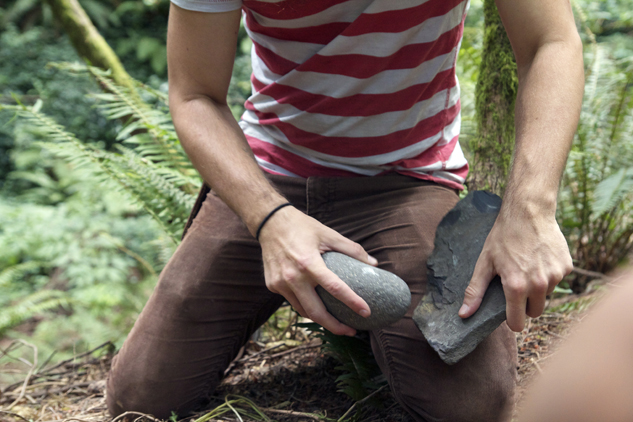Making Stone Flakes From a Columnar Basalt Core
For a while now I’ve been playing around with making tools from hard stone. I’m not a great knapper. I’m not really even a good one. I’m a novice when it comes to making beautiful arrowheads and knives. I can make functional arrowheads, and functional knives from obsidian or even glass bottles. My concern has always been… what good is glassy obsidian for doing, well, real things? I mean, sure if you want to skin an animal obsidian makes perfect razor blades for the job. If you want to carve a bow-drill notch, or score a bone, or saw through a willow shoot, Obsidian is not going to cut it.
So during the spring I was on a hike with my lady along a river and I saw a stone that was broken and shaped similarly to obsidian, but was a dull gray/brown. It was a piece of columnar basalt. I took it home and played with making flakes using another large stone (granite? a larger grain basalt?) as a hammer stone and it was amazing. I’ve been making a bunch of flakes and even pressure flaking a little bit to get a sort of serrated edge. This stone is tough. Super hard. I’ve been asking around to the old knappers every chance I get for tips on working it. Most have suggested I find a softer basalt but a few have given me some really nice pointers that I’ll share in a later post once I’ve tried them out myself. I’ve collected quite a bit up there to play with back at home.
Here are some photos of me demonstrating how to get quality flakes for scraping tools. These are from the Teen Wilderness Skills camp I co-led for a Rewild Portland and Portland Parks and Recreation partnership.








YEAH! Basalt is awesome. I’ve always loved doing the bigger percussion work over the little pressure working of stone tools. Let me knock out a preface/biface anytime over doing an arrowhead.
Hey Joe! You don’t remember me, but I was at a California Standard class years ago (May of 2000 I think) where you did the stone tools lecture. It was awesome!
Basalt was commonly used here on NE Oregon.I have butchered an elk with a basalt blade from initial cut in the hide to quartering and removing the head. Removing back straps etc. I find the knife edges stay sharper longer than obsidian although obsidian can be used for tough jobs if you use it with its weaknesses in mind.
When working basalt I’ve found antler and hardwood billets work better than stone or copper. Your billet needs to absorb some of the shock to keep the basalt from hinging too much.
Also a little flatter angle than obsidian seems to work better.
I like my hunting knife to be basalt. Less likely to get stone flakes in the meat.
Hey Kirby,
That’s awesome that you’ve butchered a whole elk with basalt! Yeah I’ve heard the hardwood billets and moose billets work well. Do you have any recommendations for hard woods around here?
Pingback: Wet-Scraping Nutria Hides With Bone and Stone Tools « Peter Michael Bauer